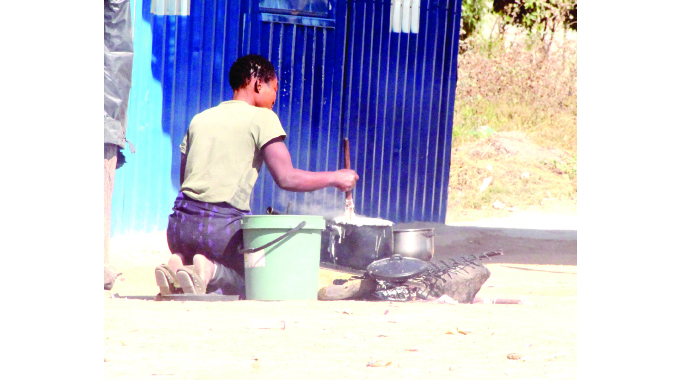Atherstone Farm provides alternative to illegal mining

Yoliswa Dube-Moyo, Matabeleland South Bureau Chief
In an area where many would rather commit to a pick and shovel to draw the precious yellow metal from the earth, Atherstone Farm in West Nicholson has proven that there is money to be made in farming.

A worker packs mealie meal at Atherstone Irrigation Scheme
Aside from cropping, the farm has also ventured into milling where a small-scale milling plant has been set up to process and package mealie-meal.
On average, the plant produces 500 by 10kg bags of mealie-meal per day.
Not only has Atherstone Farm realised lucrative dividends through its operations, it has also created employment for locals in surrounding communities.
This is in line with the country’s rural industrialisation drive under the National Development Strategy 1.
Atherstone Farm manager Mr Brynn Enslin said the farm consists of 72 hectares of arable land at the moment.
“When we started here, there was absolutely no arable land because there were miners in the fields.
As time has gone on, we’ve managed to relocate them and do land preparation.
Our target going forward in the greater scheme is to go up to 600 hectares of maize and include potatoes and onions as rotational crops,” said Mr Enslin.
At the moment, Atherstone Farm has 25 hectares of lucerne and 12 hectares of onions under cultivation.
“We expect to harvest lucerne every three to four weeks so it’s a very good cash crop and it being in Matabeleland South province, a high cattle ranching area, we look to supply all the cattle farmers.
The grazing in this area is good quality grazing, we’re on the sweet veld.
Farmers have access to the grass that’s come up as a result of the late rains,” said Mr Enslin.
Lucerne, which is also known as the “queen of forages” is one of the most nutritious forages available for cattle.
It can either be directly grazed or fed to cattle as hay and silage.
“Lucerne is a very high crude protein cattle fodder.
It’s got a crude protein percentage of between 18 and 24 percent.
It’s a very cheap form of getting your protein into your feed mixers for livestock.”
Mr Enslin said value addition was a big part of their operations hence the setting up of a small-scale milling plant.
“We grow at least 50 hectares of maize per season so we’ve decided that instead of selling the maize as stock feed, we’ll value add and create employment by setting up a small-scale milling plant where we’re milling 120 tonnes of maize per month.
It’s creating job opportunities for the locals.
West Nicholson and Umzingwane are mineral rich areas so one of the challenges that we face is trying to get labour on board.
It’s difficult to come up with a figure when paying the locals because they can just go up a mountain, dig a hole and say they’re getting at least R250 per day from that,” said Mr Enslin.
Although the enterprise has remained afloat under difficult circumstances, he said the prevailing economic conditions as a result of various factors have made the going tough for farmers.
“Farming is a business and the Covid-19 pandemic caused a lot of problems worldwide.
Now, the war on Ukraine by Russia is causing a lot of problems and we’re feeling the effects of it as farmers.

An onion field at Atherstone Farm
Our inputs have increased by at least 25 percent, which is a challenge because if fresh green onions 10 years ago were selling $1 for 12, at the moment it’s still $1 for 12 fresh green onions and yet our inputs have gone up by 25 percent.
The farmers are taking a lot of flak on that,” said Mr Enslin.
He said mining activities by artisanal small-scale miners in the area were affecting farming activities in West Nicholson to a large extent.
“The mining affects us hugely because the miners just come and put up a peg and then they start building a shaft.
The shafts they dig are about a metre by a metre, and it could go 100 metres below ground.
So when it comes to disturbing the top soils and bringing all those rocks and decomposed granite from down below onto the surface, it’s disturbing the natural process of how the top soil is supposed to grow.
We actually want to go into zero-tilling farming because one of the main causes of soil erosion worldwide is us as farmers.
We want to plant zero-till and make it eco-friendly. Obviously you’ll see more results because you’re making a micro-biology organ in the ecosystem,” said Mr Enslin.
He said Atherstone Farm will contribute immensely to dairy farming through the production of lucerne silage, specifically for dairy cattle.
“I think we’ll contribute on a massive scale because we actually make a lucerne silage which is specific for dairy farmers but our challenge at the moment has been touching base with these dairy farmers and getting the marketing out there.
We’ve got all the equipment to manufacture feed specific for dairy farming,” said Mr Enslin.
His business partner, Mr Zenzo Jele said they felt it was Atherstone Farm’s responsibility to create employment for locals.
“We feel obliged to ensure that people from our area are employed.
We have women who are helping with the maize that will be milled and packaged as mealie-meal for sale.
We also have young men who know how to mill the maize, how it is weighed and packaged in accordance with Ministry of Health and Child Care standards.
“We look at it as a ray of hope we’ve brought to the people.
It will lessen the financial burden for the people working here and prosper the area,” said Mr Jele.
Atherstone Farm employs about 35 people at any given time – to work on the fields and at the milling plant.
– @Yolisswa








Comments